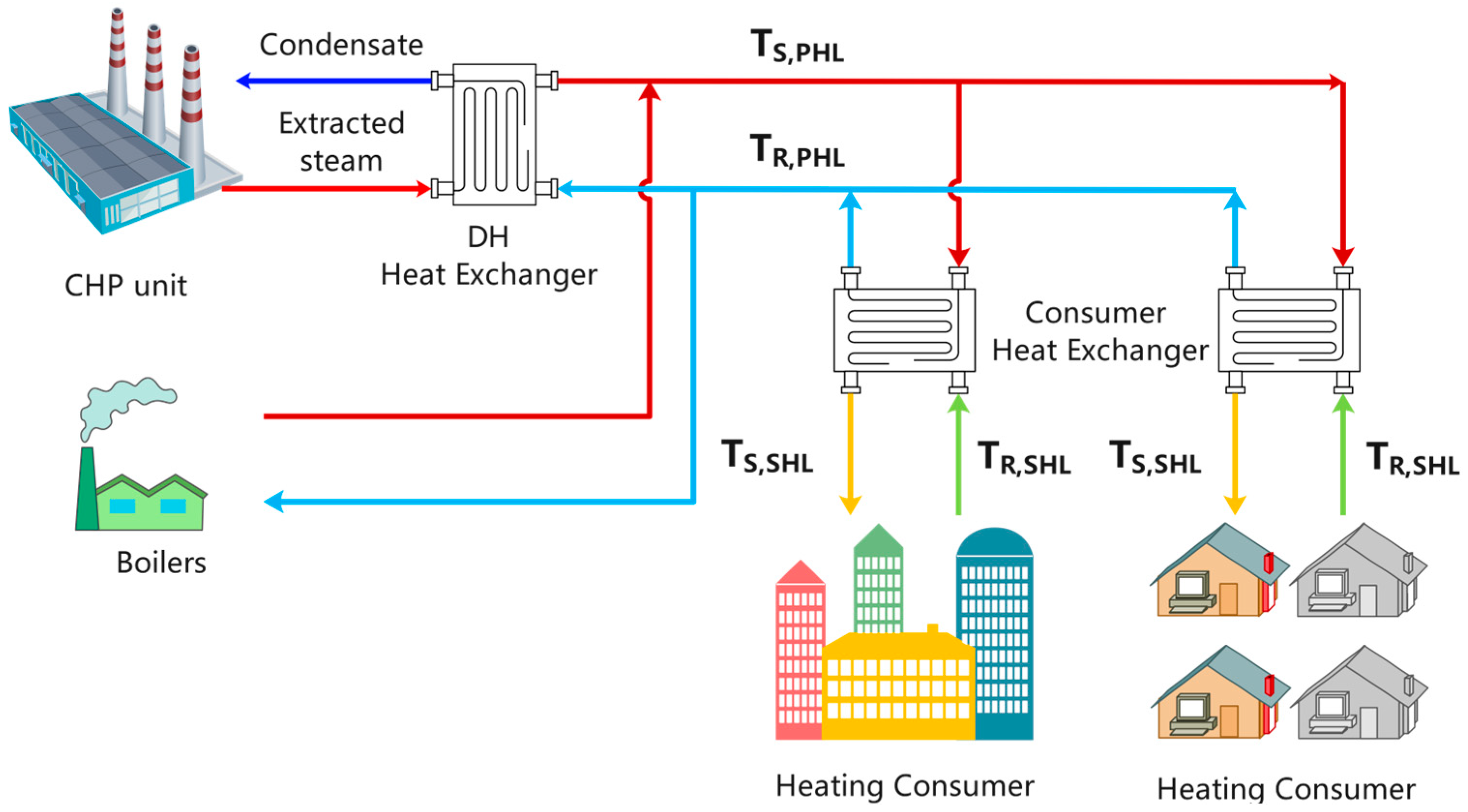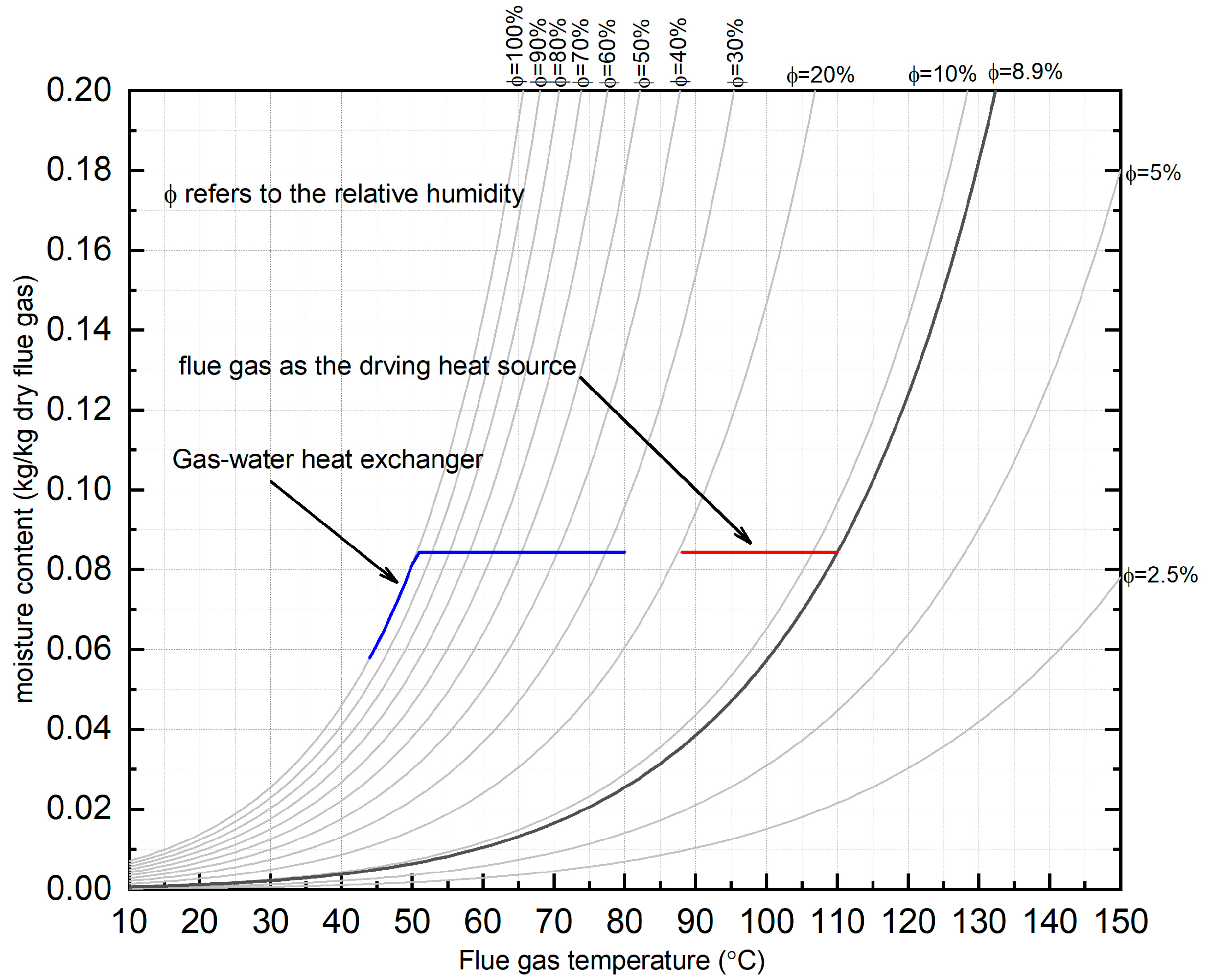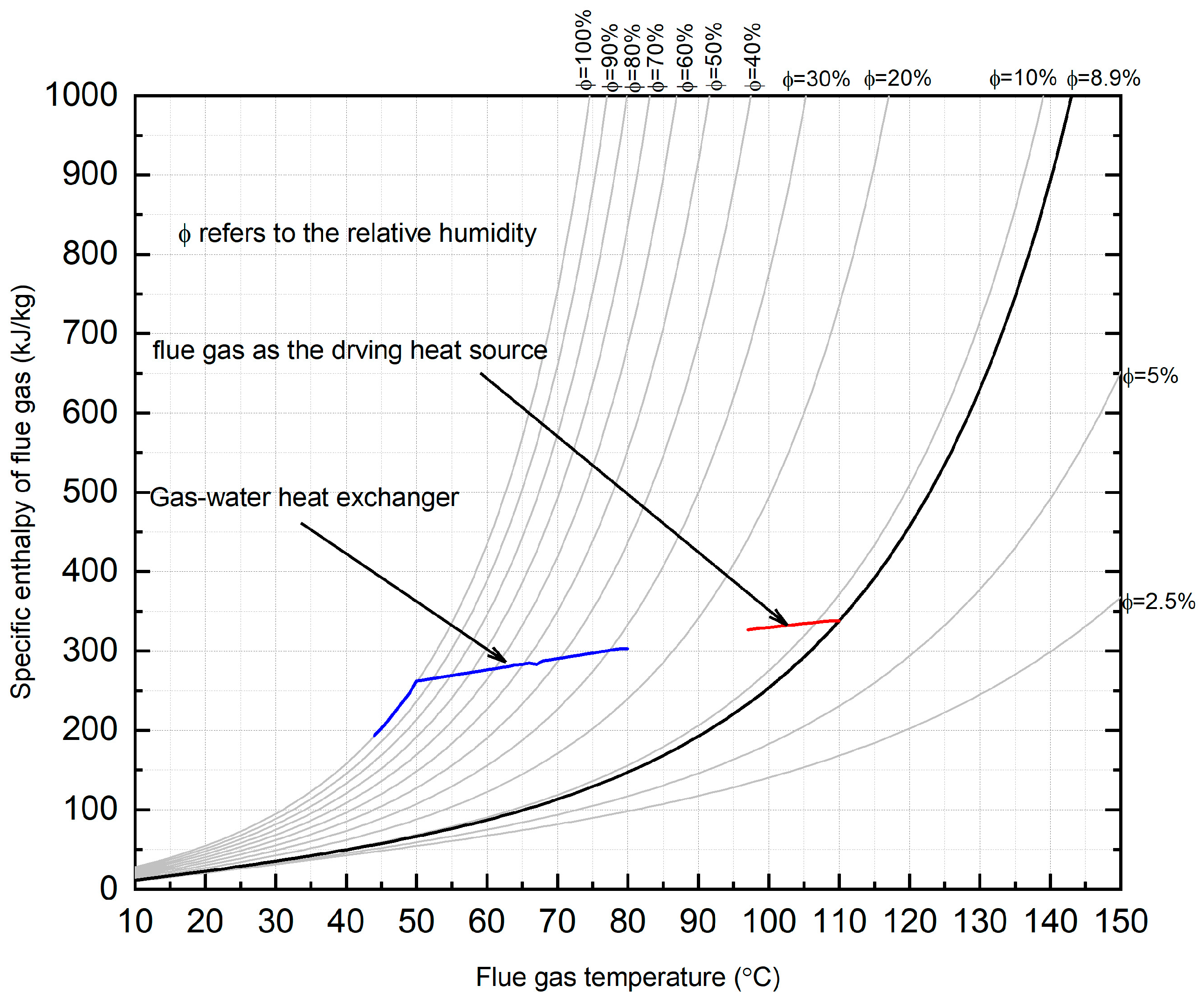Cascaded Absorption Heat Pump Integration in Biomass CHP Systems: Multi-Source Waste Heat Recovery for Low-Carbon District Heating
Abstract
1. Introduction
2. Methodology
2.1. The Description of the DH System
2.2. Parameters and Regulation Strategies of the SHL
2.3. Parameters and Regulation Strategies of the PHL
2.3.1. Combined Heating Utilizing CHP and Boilers
2.3.2. Independent Heating with CHP
2.4. Flue Gas Heat Recovery System with AHP
2.5. Waste Heat Recovery of CHP with Serial Absorption Heat Pump
3. Results and Discussions
3.1. Changes in Temperature and Flow Rates of PHL and SHL Under Different Ambient Temperatures
3.2. Heat Recovery from Waste Heat
3.3. Heat Recovery from Circulating Cooling Water
4. Conclusions
Author Contributions
Funding
Institutional Review Board Statement
Informed Consent Statement
Data Availability Statement
Conflicts of Interest
Abbreviations and Nomenclatures
| DH | district heating |
| PHL | primary heating loop |
| SHL | secondary heating loop |
| CHP | combined heat and power |
| AHP | absorption heat pump |
| FGD | flue gas desulfurization |
| TS,SHL | the supply water temperatures of the SHL |
| TR,SHL | the return water temperatures of the SHL |
| the designed SHL supply water temperatures | |
| the designed SHL return water temperatures | |
| the supply water temperatures of the PHL | |
| the return water temperatures of the PHL | |
| the designed PHL supply water temperature | |
| the designed PHL return water temperature | |
| the indoor design temperature | |
| the actual ambient temperatures | |
| the designed ambient temperatures | |
| Superscript CHP | the CHP operates at its maximum designed heating capacity |
| When the ambient temperature drops below this temperature, the combined operation of the CHP and boilers is required to satisfy the heating demand | |
| the proportion of the actual heating load at a specific outdoor temperature to the design heating load | |
| flow rates | |
| the enthalpy of the dry flue gas | |
| the enthalpy of the water vapor | |
| ) | |
| ) | |
| the saturated vapor pressure | |
| the calculation of the moisture content | |
| the relative humidity | |
| the molar masses of water vapor | |
| the molar masses of dry flue gas |
References
- International Energy Agency. District Heating. 2024. Available online: https://www.iea.org/energy-system/buildings/district-heating (accessed on 26 May 2025).
- Dang, L.M.; Shin, J.; Li, Y.; Tightiz, L.; Nguyen, T.N.; Song, H.-K.; Moon, H. Toward explainable heat load patterns prediction for district heating. Sci. Rep. 2023, 13, 7434. [Google Scholar] [CrossRef]
- Fu, L.; Li, Y.; Wu, Y.; Wang, X.; Jiang, Y. Low carbon district heating in China in 2025—A district heating mode with low grade waste heat as heat source. Energy 2021, 230, 120765. [Google Scholar] [CrossRef]
- Cai, Q.; Qiu, X.; Peng, L.; Li, Q.; Zhang, Y. Significant co-benefits of air pollutant and CO2 emission reduction from biomass energy utilization in power plants in China. Sci. Total Environ. 2023, 887, 164116. [Google Scholar] [CrossRef]
- Anvari, S.; Vera, D.; Aguado, R.; Jurado, F.; Desideri, U. Developing an off-grid biomass gasification cogeneration system for Moroccan olive oil mills: Simulation, experimental validation, and 3E analysis. Energy Convers. Manag. 2023, 298, 117781. [Google Scholar] [CrossRef]
- Zhang, H.; Zhao, H.; Li, Z. Waste heat recovery and water-saving modification for a water-cooled gas-steam combined cycle cogeneration system with absorption heat pump. Energy Convers. Manag. 2019, 180, 1129–1138. [Google Scholar] [CrossRef]
- Zhang, H.; Zhao, H.; Li, Z. Thermodynamic performance study on solar-assisted absorption heat pump cogeneration system in the coal-fired power plant. Energy 2016, 116, 942–955. [Google Scholar] [CrossRef]
- Feng, L.; Lin, D.; Lin, F.; Xiling, Z. Application of absorption heat pump and direct-contact total heat exchanger to advanced-recovery flue-gas waste heat for gas boiler. Sci. Technol. Built Environ. 2019, 25, 149–155. [Google Scholar] [CrossRef]
- Wei, M.; Fu, L.; Zhang, S.; Zhao, X. Experimental investigation on vapor-pump equipped gas boiler for flue gas heat recovery. Appl. Therm. Eng. 2019, 147, 371–379. [Google Scholar] [CrossRef]
- Xu, Z.Y.; Mao, H.C.; Liu, D.S.; Wang, R. Waste heat recovery of power plant with large scale serial absorption heat pumps. Energy 2018, 165, 1097–1105. [Google Scholar] [CrossRef]
- Aydin, D.; Casey, S.P.; Riffat, S. The latest advancements on thermochemical heat storage systems. Renew. Sustain. Energy Rev. 2015, 41, 356–367. [Google Scholar] [CrossRef]
- Mohammadi, A.; Ahmadi, M.H.; Bidi, M.; Joda, F.; Valero, A.; Uson, S. Exergy analysis of a Combined Cooling, Heating and Power system integrated with wind turbine and compressed air energy storage system. Energy Convers. Manag. 2017, 131, 69–78. [Google Scholar] [CrossRef]
- Ifaei, P.; Ataei, A.; Yoo, C. Thermoeconomic and environmental analyses of a low water consumption combined steam power plant and refrigeration chillers part 2: Thermoeconomic and environmental analysis. Energy Convers. Manag. 2016, 123, 625–642. [Google Scholar] [CrossRef]
- Ifaei, P.; Rashidi, J.; Yoo, C. Thermoeconomic and environmental analyses of a low water consumption combined steam power plant and refrigeration chillers part 1: Energy and economic modelling and analysis. Energy Convers. Manag. 2016, 123, 610–624. [Google Scholar] [CrossRef]
- Vandani, A.M.K.; Bidi, M.; Ahmadi, F. Exergy analysis and evolutionary optimization of boiler blowdown heat recovery in steam power plants. Energy Convers. Manag. 2015, 106, 1–9. [Google Scholar] [CrossRef]
- Wei, S.; Wang, J.; Song, H.; Zhou, X. Technical and Economic Evaluation on the Integrated Heating System With Coupled Heat Pump and Backpressure Turbine. J. Energy Resour. Technol. 2022, 144, 035001. [Google Scholar] [CrossRef]
- Chen, H.; Guo, S.; Song, X.; He, T. Design and evaluation of a municipal solid waste incineration power plant integrating with absorption heat pump. Energy 2024, 294, 131007. [Google Scholar] [CrossRef]
- Li, Z.; Xue, S.; Hu, D.; Teng, D.; Zhang, S.; Shen, G. Performance Analysis of an Absorption Heat Pump System for Waste Heat and Moisture Cascade Recovery from Flue Gas. ACS Omega 2022, 7, 24596–24605. [Google Scholar] [CrossRef]
- Zhang, H.; Dong, Y.; Lai, Y.; Zhang, X. Waste heat recovery from coal-fired boiler flue gas: Performance optimization of a new open absorption heat pump. Appl. Therm. Eng. 2021, 183, 116111. [Google Scholar] [CrossRef]
- Severi, C.A.; Pascual, C.; Perez, V.; Muñoz, R.; Lebrero, R. Pilot-scale biogas desulfurization through anoxic biofiltration. J. Hazard. Mater. 2025, 485, 136830. [Google Scholar] [CrossRef]
- An, X.; Tang, C.; Liu, J.; Song, X.; Huang, C. Catalytic Pyrolysis of Biomass Using Desulfurization Ash: Enhanced Bio-Oil Yields and Reaction Pathway Modulation. Energy 2025, 330, 136817. [Google Scholar] [CrossRef]
- Zhang, Z.; Li, K.; Liang, Z. Study on the removal of escaping ammonia and fly ash from biomass combustion flue gas by micro-vortex method. Renew. Energy 2025, 248, 123114. [Google Scholar] [CrossRef]
- Azeez, M.O.; Ganiyu, S.A. Review of biomass derived-activated carbon for production of clean fuels by adsorptive desulfurization: Insights into processes, modifications, properties, and performances. Arab. J. Chem. 2023, 16, 105182. [Google Scholar] [CrossRef]
- Malcher, X.; Tenorio-Rodriguez, F.C.; Finkbeiner, M.; Gonzalez-Salazar, M. Decarbonization of district heating: A systematic review of carbon footprint and key mitigation strategies. Renew. Sustain. Energy Rev. 2025, 215, 115602. [Google Scholar] [CrossRef]
- Yuan, X.; Liu, J.; Sun, S.; Lin, X.; Fan, X.; Zhao, W.; Kosonen, R. Data center waste heat for district heating networks: A review. Renew. Sustain. Energy Rev. 2025, 219, 115863. [Google Scholar] [CrossRef]
- Tien, P.W.; Wang, H.; Tokbolat, S.; Boukhanouf, R.; Calautit, J.; Darkwa, J. Application of life cycle assessment for enhancing sustainability of district heating: A multi-level approach. Energy Rep. 2025, 13, 5077–5096. [Google Scholar] [CrossRef]
- Li, T.; Chen, W.; Li, X.; Wang, B.; Shi, W. Investigation of control strategies for dual-temperature district heating substations with two absorption heat pumps and two heat exchangers. Energy Convers. Manag. 2024, 309, 118431. [Google Scholar] [CrossRef]
- Liu, G.; Zhou, X.; Yan, J.; Yan, G. Dynamic integrated control for Chinese district heating system to balance the heat supply and heat demand. Sustain. Cities Soc. 2023, 88, 104286. [Google Scholar] [CrossRef]
- Razmi, A.; Soltani, M.; Torabi, M. Investigation of an efficient and environmentally-friendly CCHP system based on CAES, ORC and compression-absorption refrigeration cycle: Energy and exergy analysis. Energy Convers. Manag. 2019, 195, 1199–1211. [Google Scholar] [CrossRef]
- Brückner, S.; Liu, S.; Miró, L.; Radspieler, M.; Cabeza, L.F.; Lävemann, E. Industrial waste heat recovery technologies: An economic analysis of heat transformation technologies. Appl. Energy 2015, 151, 157–167. [Google Scholar] [CrossRef]
- Lake, A.; Rezaie, B.; Beyerlein, S. Review of district heating and cooling systems for a sustainable future. Renew. Sustain. Energy Rev. 2017, 67, 417–425. [Google Scholar] [CrossRef]
- Zhang, L.; Li, Y.; Zhang, H.; Xu, X.; Yang, Z.; Xu, W. A review of the potential of district heating system in Northern China. Appl. Therm. Eng. 2021, 188, 116605. [Google Scholar] [CrossRef]
- Cheng, L.; Feng, H.; Guo, H. Comparison of China-ASHRAE HVAC Design Criteria in Coal-fired Power Plants. IOP Conf. series. Earth Environ. Sci. 2020, 461, 12068. [Google Scholar] [CrossRef]
- ASHRAE and the American National Standards Institute. Climatic Data for Building Design Standards. 2021. Available online: https://www.ashrae.org/file%20library/technical%20resources/standards%20and%20guidelines/standards%20addenda/169_2020_a_20211029.pdf (accessed on 26 May 2025).
- He, P.; Sun, G.; Wu, H. Heating Engineering; China Architecture & Building Press: Beijing, China, 2021. [Google Scholar]
- Xu, L.; Yuan, J. Thermodynamic properties calculation of the flue gas based on its composition estimation for coal-fired power plants. Appl. Therm. Eng. 2015, 90, 366–375. [Google Scholar] [CrossRef]
- Su, K. Technology Development and Research of Waste Heat Deep Utilization for High-Moisture Flue Gas. Master’s Thesis, Zhejiang University, Hangzhou, China, 2021. (In Chinese). [Google Scholar]
- Xun, J. A Group of Simple Precise Formulations for Properties of Water and Steam. Power Eng. 2003, 23, 2777–2780. [Google Scholar]
- NCE—Web Calculation Framework. Antoine’s Equation. Available online: https://www.chesolver.com/antoine/result (accessed on 26 May 2025).
- Wang, P.; Zhang, S. Retrofitting Strategies Based on Orthogonal Array Testing to Develop Nearly Zero Energy Buildings. Sustainability 2022, 14, 4451. [Google Scholar] [CrossRef]
- Mu, L.; Wang, S.; Lu, J.; Liu, G.; Zhao, L.; Lan, Y. Effect of flue gas condensing waste heat recovery and its pressure drop on energy saving and carbon reduction for refinery heating furnace. Energy 2023, 279, 128081. [Google Scholar] [CrossRef]
- El-Shafie, M.; Khalil Bassiouny, M.; Kambara, S.; El-Behery, S.M.; Hussien, A. Design of a heat recovery unit using exhaust gases for energy savings in an absorption air conditioning unit. Appl. Therm. Eng. 2021, 194, 117031. [Google Scholar] [CrossRef]
- Huicochea, A. A novel advanced absorption heat pump (Type III) for cooling and heating using low-grade waste heat. Energy 2023, 278, 127938. [Google Scholar] [CrossRef]
- Ahmad, T.; Azhar, M.; Sinha, M.K.; Meraj, M.; Mahbubul, I.M.; Ahmad, A. Energy analysis of lithium bromide-water and lithium chloride-water based single effect vapour absorption refrigeration system: A comparison study. Clean. Eng. Technol. 2022, 7, 100432. [Google Scholar] [CrossRef]
- Dinçer, İ.; Zamfirescu, C. Sustainable Energy Systems and Applications; Springer: New York, NY, USA, 2011. [Google Scholar]
- Mussati, S.F.; Gernaey, K.V.; Morosuk, T.; Mussati, M.C. NLP modeling for the optimization of LiBr-H2O absorption refrigeration systems with exergy loss rate, heat transfer area, and cost as single objective functions. Energy Convers. Manag. 2016, 127, 526–544. [Google Scholar] [CrossRef]











| Ultimate Analysis (as Received Basis) | Proximate Analysis (as Received Basis) | Qar,net(MJ/kg) | |||||||
|---|---|---|---|---|---|---|---|---|---|
| Car (%) | Har (%) | Oar (%) | Nar (%) | Sar (%) | Mar (%) | Aar (%) | Var (%) | FCar (%) | |
| 41.68 | 4.78 | 35.66 | 0.71 | 0.04 | 10.02 | 7.11 | 57.73 | 25.14 | 14.49 |
| CO2 | N2 | O2 | Superheated Steam | Saturated Steam | |
|---|---|---|---|---|---|
| C1 | −202.8900 | −286.8698 | −251.6035 | 2026.3840 | 2.4878 × 103 |
| C2 | 0.6395 | 1.0686 | 0.9381 | 1.6485 | 2.2850 |
| C3 | 3.7800 × 10−4 | −9.9019 × 10−5 | −1.0047 × 10−4 | 3.1456 × 10−4 | −3.8581 × 10−3 |
| C4 | -- | 1.1631 × 10−7 | 1.3973 × 10−7 | −2.1905 × 104 | -- |
| C5 | -- | -- | -- | 2.5344 | -- |
| C6 | -- | -- | -- | −4.1490 × 1025 | -- |
| C7 | -- | -- | -- | 9.2160 | -- |
| Design Parameters | Value |
|---|---|
| SHL supply water temperature (°C) | 65 |
| SHL return water temperature (°C) | 40 |
| PHL supply water temperature (°C) | 120 |
| PHL return water temperature (°C) | 50 |
| Heat index (W/m2) | 56.3 |
| Heating area (m2) | One million |
| Heating design ambient temperature (°C) | −23 |
| Indoor design temperature (°C) | 18 |
| The maximum designed heating capacity of the CHP | 65.28% |
| The limit temperature for CHP standalone heating (°C) | −8.8 |
Disclaimer/Publisher’s Note: The statements, opinions and data contained in all publications are solely those of the individual author(s) and contributor(s) and not of MDPI and/or the editor(s). MDPI and/or the editor(s) disclaim responsibility for any injury to people or property resulting from any ideas, methods, instructions or products referred to in the content. |
© 2025 by the authors. Licensee MDPI, Basel, Switzerland. This article is an open access article distributed under the terms and conditions of the Creative Commons Attribution (CC BY) license (https://creativecommons.org/licenses/by/4.0/).
Share and Cite
Wang, P.; Zhou, H. Cascaded Absorption Heat Pump Integration in Biomass CHP Systems: Multi-Source Waste Heat Recovery for Low-Carbon District Heating. Sustainability 2025, 17, 5870. https://doi.org/10.3390/su17135870
Wang P, Zhou H. Cascaded Absorption Heat Pump Integration in Biomass CHP Systems: Multi-Source Waste Heat Recovery for Low-Carbon District Heating. Sustainability. 2025; 17(13):5870. https://doi.org/10.3390/su17135870
Chicago/Turabian StyleWang, Pengying, and Hangyu Zhou. 2025. "Cascaded Absorption Heat Pump Integration in Biomass CHP Systems: Multi-Source Waste Heat Recovery for Low-Carbon District Heating" Sustainability 17, no. 13: 5870. https://doi.org/10.3390/su17135870
APA StyleWang, P., & Zhou, H. (2025). Cascaded Absorption Heat Pump Integration in Biomass CHP Systems: Multi-Source Waste Heat Recovery for Low-Carbon District Heating. Sustainability, 17(13), 5870. https://doi.org/10.3390/su17135870






